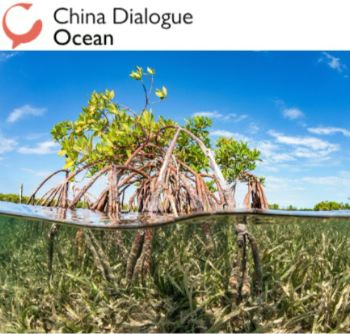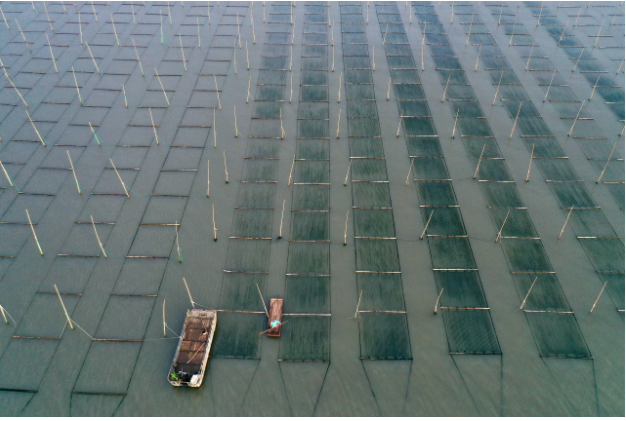|

Protecting and restoring coastal ecosystems such as mangrove forests and seagrass meadows is one way of absorbing CO2 from seawater (Image: Mathieu Fo
Six ways the ocean could (potentially) mop up CO2 emissions
 WORLDWIDE WORLDWIDE
Wednesday, September 27, 2023, 07:00 (GMT + 9)
The following is an excerpt from an article published by China Dialogue Ocean:
Several proposals exist for enhancing the ocean’s carbon-capturing capacity. But they are nascent, untested and may cause more problems than they solve
 As anyone who has enjoyed a fizzy drink knows, CO2 dissolves in water – refreshing news for our gullets, and good news for our planet. With more than 70% of the Earth’s surface covered by the water in our ocean, this basic physical process acts as a brake on global warming on a massive scale. As anyone who has enjoyed a fizzy drink knows, CO2 dissolves in water – refreshing news for our gullets, and good news for our planet. With more than 70% of the Earth’s surface covered by the water in our ocean, this basic physical process acts as a brake on global warming on a massive scale.
Since the dawn of the Industrial Revolution, a quarter of humanity’s CO2 emissions from the burning of fossil fuels have been absorbed by the ocean. The seas, in other words, have helped to clean up our mess. In doing so, they have lowered greenhouse gas levels in the atmosphere and limited global warming.
Unfortunately, as the rate of human-driven emissions has increased, the oceans have been unable to store carbon away quickly enough to prevent warming entirely. But could they?
Some scientists believe the carbon-uptake of the oceans can be artificially accelerated. They have suggested a range of technologies, from the complex to the very simple. If successful, they could help us in coming decades as the world struggles to move towards a low-carbon economy.
Ocean-based carbon dioxide removal (CDR) schemes, as they are called, are controversial. They are mostly untested – certainly at the scale that would be required – and could come with damaging side effects. They could be expensive and might act as a distraction from the urgent need to reduce emissions. But they could also offer a helping hand when we most need it.
As the profile of such CDR proposals rises, a growing number of scientists are weighing up their risks and benefits. A key report from the US National Academies of Sciences, Engineering and Medicine has identified the following possible methods as the most promising.
Farming seaweed
Just like phytoplankton, seaweed takes CO2 and uses it to grow. In fact, phytoplankton are themselves a form of seaweed – a catch-all term used to describe a wide range of marine plants and algae.

A farm growing laver, also known as nori, a popular edible seaweed, off the coast of Sansha, Fujian province, China. Seaweed farming would need to be significantly scaled up to remove enough CO2 to have an impact on the climate. (Image: Amadeja Plankl / Alamy/China Dialogue Ocean)
Most plans to cultivate and farm seaweed focus on the plants that grow in rocky coastal waters, which presents a problem for carbon storage. Unlike the phytoplankton that can fall for thousands of metres through the deep sea and bury their carbon in seabed sediment, larger coastal seaweeds have long been thought to mostly disintegrate in shallow water and come to rest on hard stone surfaces at the bottom. These surfaces are more likely to be disturbed, making it more likely that this carbon will be re-released into the atmosphere. But some research says it’s more complicated than that, and that much carbon from coastal seaweed can indeed end up in deep-sea sediment.
Either way, just like planting trees on land, growing more seaweed is an attractive way to trap and store carbon for a while – the key is what to do with it next. Perhaps it could be harvested and used as biomass for energy. Or it could be fed to animals, or people. Incentives would be important: some proponents of seaweed cultivation for carbon storage argue that it should generate credits that can be sold to consumers and companies to offset their own greenhouse gas emissions. Seaweed farming is already done around the world, but it would need to be significantly scaled up to have an impact on climate. And some are anxious that setting up yet more infrastructure in the ocean could impact existing marine life.[...]
Author: David Adam | Read the full article by clicking the link here
editorial@seafood.media
www.seafood.media
|



